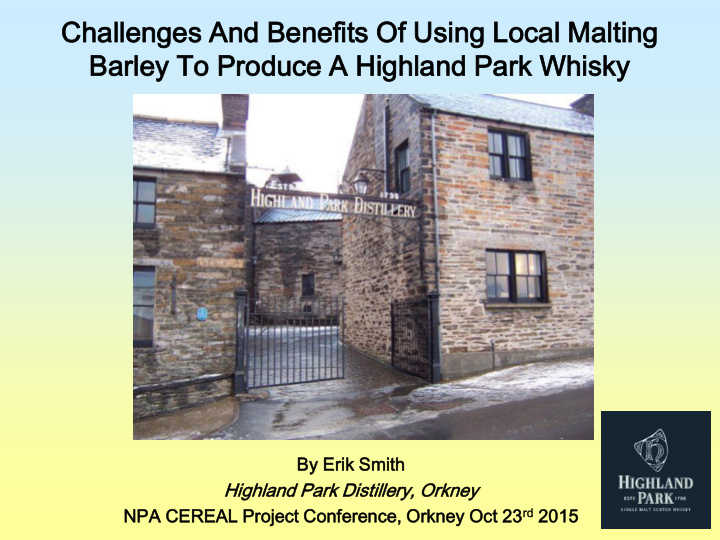



Ch Challe lenge nges s An And Be Benefits fits Of Of Us Using g Local al Malting ing Ba Barley y To To Pr Produc uce A A Highla land d Pa Park Whisky ky By Erik k Smith th Highland Park Distil illery, ry, Orkney rd 2015 NPA CEREAL AL Project ject Confere erence, ce, Orkney ney Oct 23 rd 2015
Intro troduc ductio ion Origins of HP can be traced back to 1798 Since then it has become a world famous malt whisky brand Its current success can be attributed to the quality of its whisky, much of which results from its continuation of traditional practices – e.g. use of locally sourced peat, traditional water supply, dunnage warehouses and especially its own floor malting. Only about 6 other distilleries in Scotland continue to run their own floor malting facilities – this contributes a unique character to our whiskies. Crucially, for this presentation, our floor malting facility has allowed HP to develop the marketing concept of producing an “All - Orkney whisky” where every step of the process will be done in Orkney, including growing the barley.
An An Al All-Or Orkn kney ey Wh Whis isky ky To start developing an all-Orkney whisky, we had to: • Find d a modern rn malting ng barley ey variety ety which h grows well in Orkney ey and produc uces es good d malt – ‘Tartan’ identified (PSY >420 l/t) • Establish a supply chain for ‘Tartan’ For both of these, e, collabor aborat ation on with the Agronomy onomy Insti titut tute e was import rtant. ant. Some Challenges: • The Tartan an supply pply chain ain produces duces c. 60 t o of grain n annual ually (Sept pt/O /Oct) t). Optimum um germinat nation on for malting ng is several eral months hs later r – we need d to dedicate ate one grain n storage age bin to the projec ect. • To produc duce e a p pure Tartan n spirit, t, malting ng and disti tillati ation on of Tartan an is carried ed out immediat diately ely on return after the summer “shut down” when all equipment pment has been n thoroughl oughly cleaned aned of other er grain/mal n/malt t – about ut 1 year after the Tartan n was harves ested. ted. • Malting ng char arac acter teristi tics of Tartan n – quicker er to malt, and gener erat ates es a higher her temper peratur ature, e, than than other er barley ey used ed by HP.
An An Al All-Or Orkn kney ey Wh Whis isky ky Further Challenges: • Tartan an seed ed no longer ger commer mercial ally availabl able: e: o The AI helps each grower in the supply chain to maintain their own line of farm- saved seed. o Also helped by McCreath, Simpson & Prentice who hold a reserve batch of Tartan seed from each grower (for insurance) and clean and dress each year’s seed. • Expens pense. e. Local al Tartan an is much h more expens ensive than n purchas hasing ng malting ng barley ey in Aber erdeen deen as: o Small scale processing in Orkney is costly. o The grain price offered to Orkney growers has to be attractive (but, premiums and deductions encourage high quality). • Even en though ugh the whisky will not be releas ased ed for many year ars, , we are confi fident dent the high h cost of the projec ect will be offset et by long-ter erm m benefi efits ts.
An An Al All-Or Orkn kney ey Wh Whis isky ky - Be Bene nefi fits ts The project will produce an exceptional HP single malt whisky with unique provenance and a very strong marketing story. The whisky will be a novel product which will help to keep the brand interesting to its followers. The project has a positive economic impact on the Orkney farming community and has made the island the most northerly producer of malting barley in Scotland. The project is popular at all levels of the company, our customers easily relate to it, and it is good for HP’s public relations.
Recommend
More recommend